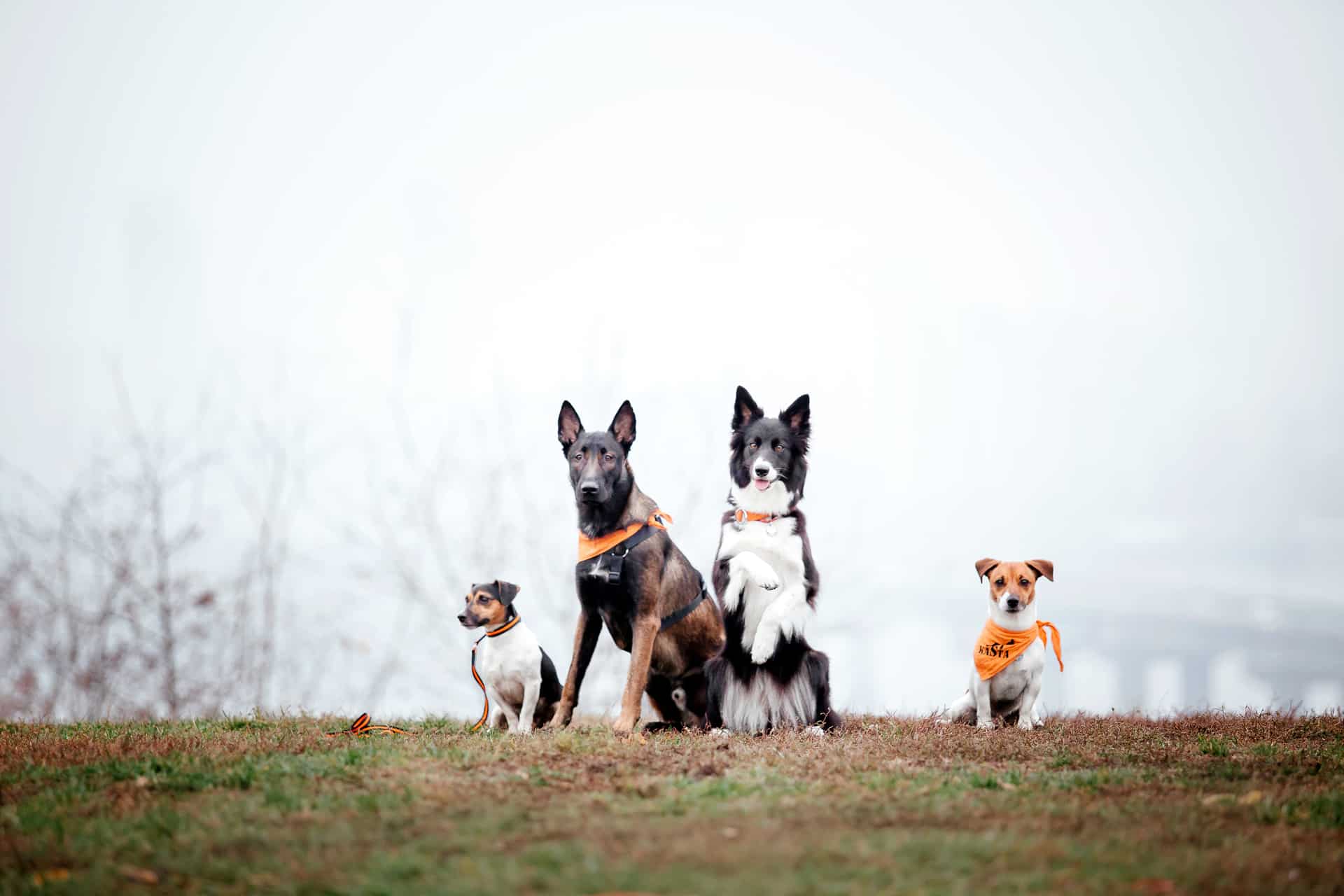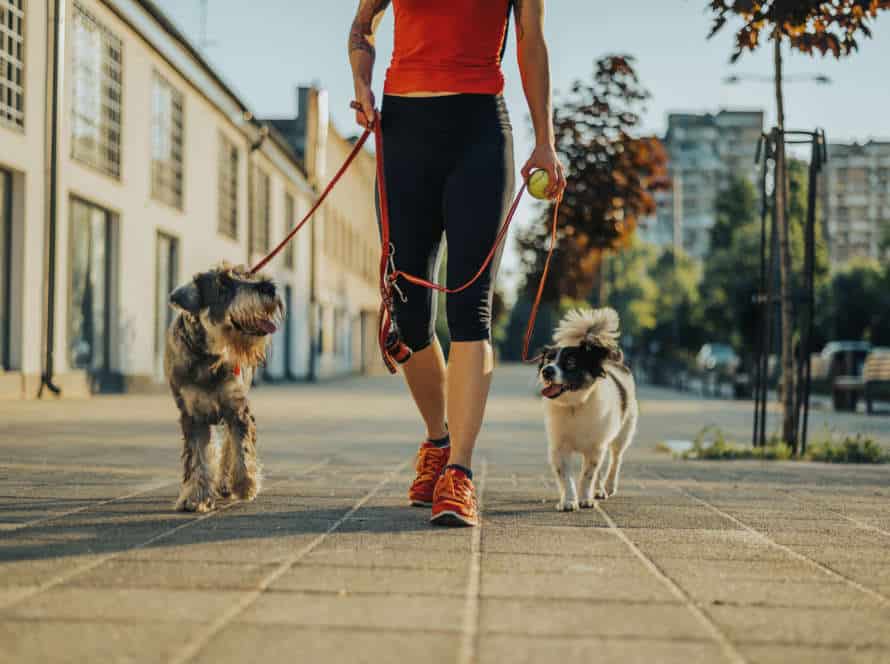The Impact of Exercise on Your Dog’s Behavior
Exercising can have a huge effect on your pup’s behavior. It can help lower bad behaviors and support overall health and well-being. Here are the advantages:
- Burns Off Energy: Exercise helps burn off your dog’s too much energy, avoiding things like chewing, digging, and hyperactivity.
- Encourages Socialization: Exercise gives your pup an opportunity to meet other people and dogs, helping to lower fear and aggression.
- Enhances Health: Exercise aids in keeping a healthy weight and keeps bones, muscles, and joints strong.
- Provides Mental Stimulation: Exercise gives mental stimulation, helping to prevent boredom and stress.
It’s important for pup parents to recognize the significance of regular exercise for their furry friend. Doing so will promote their health and joy.
The Behavioral Benefits of Exercise for Dogs
Exercise – regular and consistent – can have awesome effects on your pup’s conduct. Keeping your doggo active and stimulated both physically and mentally can help them stay fit and cultivate good habits. It can also ease anxiety, help them grow properly and even make them calmer.
Let’s delve into the advantages of exercise for your dog’s behavior!
Physical Exercise Can Help with Anxiety and Depression
Physical exercise is not only good for humans, but also our furry friends- dogs! It can help with their behavior and ease anxiety/depression. Exercise helps them release extra energy and frustration, keeping them calm and content all day. Plus, it promotes better sleep and lessens destructive behavior due to boredom.
Here are some of the behavioral benefits of regular exercise for dogs:
- Less anxiety/depression: Exercise releases endorphins, which can boost their mood, reduce stress, and ease anxiety and depression symptoms.
- Better social skills: Regular exercise can help dogs become calmer and more balanced, making it easier for them to interact with other dogs and humans.
- Less destructive behavior: Dogs that exercise regularly are less likely to do destructive things like chewing, digging, and excessive barking.
In conclusion, regular exercise is essential to help your dog maintain good behavior, leading to a happier and healthier life!
Exercise Reduces Destructive Behavior
Exercise is a powerful way to stop bad behavior in dogs. It helps reduce stress, worry, and boredom. All of these can make dogs act out. Here’s what exercise can do:
- Lower stress: Exercise helps dogs feel less stressed. That can help stop them from chewing or digging.
- Less anxiety: Dogs who are anxious may act out as a way to cope. Exercise can help them feel better.
- Less boredom: If a dog is bored, they can act out for something to do. Exercise gives them something interesting to do.
In the end, exercise is key to helping dogs with their behavior. It isn’t just good for their bodies, but their minds too. Another tip: A tired pup is a good pup!
Exercise Helps with Aggression Issues
Struggling with an aggressive pup? Exercise can be the answer! It’s a great way to use up all that energy and fight off bad behavior. Here’s how it could help:
- Exercising can help use up all that extra energy, making your dog more relaxed and focused.
- It produces endorphins which reduces stress and anxiety.
- It also stimulates their mind, which is key for their general well-being and attitude.
- Plus, if they’re tired, they won’t bark, chew or act out aggressively – a win for everyone!
Pro tip: A mix of physical and mental activities every day will help improve your pup’s behavior and enhance your bond.
How Much Exercise Your Dog Needs?
Exercise is a must for our canine friends! It’s vital for their mental and physical health. Dogs need regular exercise to stay alert, sharp and healthy. But how much exercise? This section will talk about the benefits of giving them the correct amount.
Breed and Age as Factors
Age & breed are key factors to consider when thinking about your dog’s exercise needs. Puppies and seniors need different types of exercise than adult dogs. Puppies should do low-intensity activities. Seniors might have health issues that limit their mobility. Adult dogs need 30 mins to 2 hrs of exercise, depending on breed and energy level. High-energy breeds, like Border Collies and Aussies, will need more exercise than low-energy breeds, like Bulldogs or Basset Hounds. Knowing your dog’s age and breed can help you decide the right amount of exercise they need. Tailoring activities to their needs helps keep them physically & mentally healthy.
Assessing Your Dog’s Exercise Needs
Assessing your pup’s exercise needs is vital for their mental and physical health. It depends on their breed, energy level, age, and health. Here are some guidelines:
- Small breeds: 30 minutes of moderate exercise each day.
- Medium breeds: One hour of moderate exercise each day.
- Large breeds: Two hours of moderate exercise each day.
- High energy breeds: 2-3 hours of vigorous exercise daily.
It’s important to remember that every dog is unique, and their exercise needs should be evaluated individually. Exercise helps in reducing anxiety and destructive behavior, promoting better sleep, and lifting their spirits.
Pro tip: Consult your vet to create an exercise routine tailored to your dog’s specific needs.
How to Incorporate Exercise into Your Dog’s Routine
Exercise is important for your pup’s physical and mental wellbeing. How much exercise your pooch needs depends on their breed, size, and age. Here are some ways to get them movin’:
- Take them for a walk or jog around your neighborhood, a park, or a hiking trail.
- Play fetch or chase in a safe space.
- Enroll your dog in an exercise or agility class.
- Use puzzle toys or hide-and-seek games to keep them active indoors.
Regular exercise can also improve your pup’s behavior, making them less destructive and better behaved.
It’s recommended that dogs get 30 minutes to 2 hours of exercise daily, based on their breed and size.
Types of Exercise for Dogs
Exercising is a wonderful way to keep your pup healthy! It helps them stay fit, exhaust extra energy and can even stimulate their minds. The kind of exercise that’s right for your dog depends on its breed, age, and size. Let’s talk about all the types of exercise that can help your doggy become strong and smart!
Walking & Running
Walking and running are two great exercises for dogs. They have positive effects on their behavior and wellbeing.
Walking – it provides physical and mental stimulation. Dogs like exploring new sights and smells. It can be adapted to your dog’s age, breed, and health conditions. It also helps to reduce stress and anxiety.
Running – it’s great for burning energy and keeping your dog fit. It’s especially good for high-energy breeds. It strengthens the bond between you and your pup and can reduce aggression, depression, and boredom.
When exercising your dog, start with short sessions, and then increase intensity and duration, based on their abilities and needs.
Playing Fetch and Tug-of-War
Playing fetch and tug-of-war are two exercises that can have a great effect on doggy behavior. Fetch is awesome for burning energy and stimulating their minds. Here are some tips to get the most out of it:
- Start with easy tasks and make it more complex.
- Use a soft, light ball or toy that won’t harm teeth or gums.
- Let them know when the game ends, so they don’t get frustrated.
Tug-of-war is great for strengthening the bond between you and your pup. Here are a few ideas:
- Use a tug toy, not a regular one.
- Set clear rules before playing.
- Let them “win” every now and then.
Swimming
Swimming is great exercise for dogs! It gives lots of benefits, including better heart health, strong muscles, flexibility and better behavior.
Types of swimming exercises for dogs:
- Doggy paddle: This is the basics – paddling and using legs to move around in the water.
- Deep water retrieving: Throw a toy or ball deep in the water, and watch your pup swim and retrieve it.
- Dock jumping: Jump off a dock into the water, then swim back to shore.
Swimming can also help anxious or hyperactive dogs. It releases endorphins that make them relaxed and reduce stress. Doing it regularly will make a difference in their behavior both in and out of the water.
Other Benefits to Exercise for Your Dog’s Health
Exercise is essential for the physical health of your pup. But, it can also affect their behavior and mental health! Activity can burn off extra energy, helping them concentrate and be more relaxed. Exercise strengthens muscles and decreases pain. Plus, it enhances overall wellbeing!
Here are some more benefits of regular exercise for your pup’s life quality:
- It increases cardiovascular health and decreases the risk of obesity
- It boosts their immune system
- It reduces depression and anxiety
- It improves digestion and metabolism
- It promotes healthy sleep patterns
- It helps strengthen the bond between you and your furry friend
Weight Control
Exercising regularly offers numerous benefits for your pup. It helps keep them from becoming overweight and reduces the chance of diabetes, heart disease, and arthritis. Plus, it stimulates their digestion and keeps muscles and joints flexible.
On top of physical benefits, exercising also positively affects your pup’s mental health. They’ll be calmer, more content and show less destructive behavior. It also combats stress and anxiety, making them happier.
So, make sure you give your pup regular walks and play sessions to maintain a healthy weight and improve their behavior.
Heart Health
Exercise can improve a dog’s heart health, as well as its general well-being and behavior. It can strengthen the heart, boost blood flow and circulation, and reduce the risk of heart disease. Plus, exercise helps maintain a healthy weight and lower the risk of obesity-related illnesses like diabetes and joint problems.
Exercise has a positive effect on a dog’s behavior too. It reduces anxiety, aggression, and destructive behavior. Dogs with regular exercise tend to be more relaxed and content, leading to a happier and healthier lifestyle.
To get the health benefits of exercise, give your dog at least one hour of physical activity daily. This includes moderate walking, running, and playtime. Talk to your vet to know what’s best for your dog based on age, breed, and health status.
Joint Health
Joint health is very important for your pup’s wellbeing. Exercise can make a huge impact on it! It helps strengthen muscles around the joints and improves stability, reducing the risk of injury. Also, keeping a healthy weight reduces the strain on the joints and the risk of joint-related conditions.
Plus, exercise has other benefits for your pup, such as:
- Lowering the chance of obesity & related health issues
- Regulating energy and improving sleep
- Reducing anxiety and boosting mood
Overall, exercise is an essential part of your pup’s routine for keeping healthy joints, good health, and better behavior. Consult your vet to find the best exercise routine for your pup’s needs & limitations.
Precautions When Exercising with Your Dog
Exercising with your pooch can be a blast for both of you! But, for safety and your pup’s well-being, precautions must be taken. Here’s some measures you should take for an enjoyable and safe exercise session. Enjoy!
Avoid Over-Exertion
Exercising with your pup can be an awesome way to bond. But, be careful to not over-exert them. Otherwise, fatigue, injuries, or behavioral issues could occur. Here are a few tips for exercising with your pup:
- Start Slow: Begin with low-impact activities and make the intensity and duration of the workout longer over time.
- Watch for Signs of Tiredness: Look out for heavy panting, drooling, sluggishness, or if they don’t want to carry on. If they show these signs, take a break and offer water.
- No High-Impact Activities: Jumping, running on hard surfaces, and strenuous activities can cause too much strain on their joints and lead to injuries.
- Check Their Age and Health: Older dogs, pups, or dogs with pre-existing health conditions may not be able to do intense exercise.
By following these precautions, you can make sure your pup stays safe, healthy, and happy during your exercise routine.
Assessing Weather Conditions
Checking weather conditions is essential when exercising with your pup. Things like temp, humidity and rain can affect your dog’s ability to be comfortable and safe. Here are some points to keep in mind when assessing the weather for exercising with your doggo:
- Temperature: Dogs can get overheated, which can lead to dehydration, heat exhaustion and heatstroke. Don’t exercise during the hottest parts of the day. Keep sessions short if it’s too hot.
- Humidity: High humidity makes it hard for dogs to cool down through panting, causing overheating. Be careful when exercising with high humidity and take breaks as needed.
- Precipitation: Rain, snow and ice can make surfaces slippery and increase chances of falls and injuries. Wear the right shoes and consider not exercising in extreme weather.
- Pro tip: Always have water and a bowl for your dog to drink from during sessions. Monitor their behavior for signs of distress or discomfort.
Consulting a Veterinarian Before Starting a Dog Exercise Program
Consulting with a vet is vital before beginning a dog exercise program. It’ll ensure your pup is healthy and ready for physical activity. Exercising with your dog has multiple benefits, but take precautions to avoid injuries and bad behaviors. Here are some tips:
- Start Slow: Begin small, especially if your dog is out of shape or hasn’t exercised for a while. Do shorter walks or runs and increase duration and intensity gradually.
- Watch the Weather: Avoid exercising when it’s too hot, humid, or cold. Dogs can get heatstroke and frostbite if not properly protected.
- Hydration: Bring water for your dog and give it often. Especially on hot days.
- Observe Behavior: Monitor your dog during and after exercising. If there’s fatigue, discomfort, or labored breathing, stop and see a vet.
Different breeds have different exercise needs. Excessive exercise can harm your pup physically and mentally. Consult with a vet before starting, to make sure you find the right type of exercise for your pup’s breed, size, and age.
Frequently Asked Questions
Q: How does exercise affect my dog’s behavior?
A: Exercise is crucial for your dog’s physical and mental well-being. It helps to reduce stress, anxiety, and hyperactivity, and promotes better sleep and relaxation. Regular exercise can also improve cognitive function, memory retention, and overall mood.
Q: What type of exercise is best for my dog?
A: The best type of exercise for your dog depends on its breed, age, and health condition. Generally, brisk walks, running, and playing fetch are ideal for most dogs. However, it’s important to consult with your veterinarian to determine an appropriate exercise plan for your dog.
Q: How often should I exercise my dog?
A: The frequency and duration of exercise for your dog depend on its age, breed, and physical fitness level. Generally, most dogs require at least 30 minutes of exercise per day, but some may need more. Your veterinarian can provide recommendations based on your dog’s individual needs.
Q: Can exercise help with my dog’s behavioral issues?
A: Yes, exercise can be an effective way to alleviate behavioral issues such as anxiety, aggression, and destructive behavior. Regular exercise can help your dog to release pent-up energy and reduce stress, which can lead to more balanced behavior.
Q: What are the risks of over-exercising my dog?
A: Over-exercising your dog can lead to fatigue, injury, and heatstroke. Dogs that are older, overweight, or have pre-existing medical conditions are particularly susceptible to these risks. It’s important to monitor your dog’s exercise routine and adjust it accordingly.
Q: How can I make sure my dog is getting enough exercise?
A: One way to ensure your dog is getting enough exercise is to establish a regular routine that includes a mix of physical and mental stimulation. You can also use activity trackers and consult with your veterinarian to monitor your dog’s fitness level.







